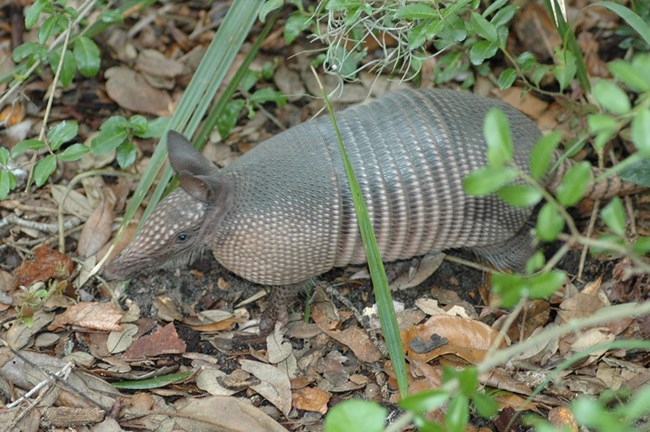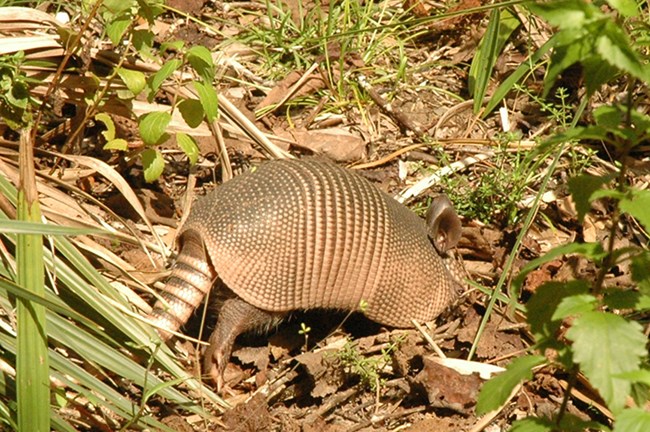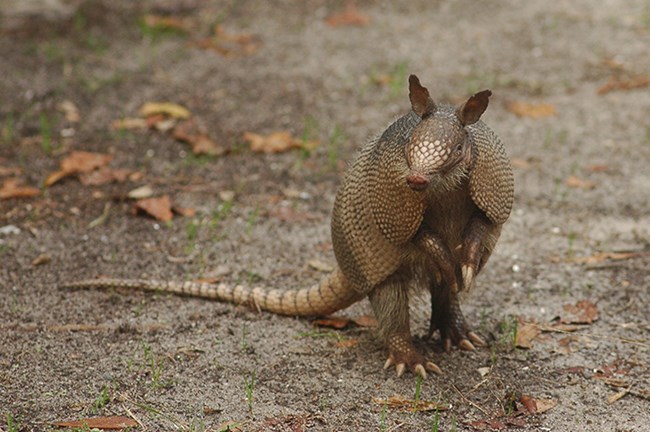
NPS Photo The nine-banded armadillo (Dasypus novemaintus) is a favorite with visitors to Cumberland Island National Seashore. Often seen with its long snout to the ground foraging for food, this unique-looking mammal thrives in the expansive maritime forest found here on the island. Coat of ArmorSpanish for "little armored one," armadillos are the only mammal with a bony plate, which is covered by brown, leathery skin. Although named "nine-banded" they can have between seven and eleven bands. Averaging the size of a house cat, armadillos can weigh anywhere between seven and seventeen pounds. they have short, muscular legs with 4 toes on its forefeet and five on its hind ones. All toes are equipped with long, strong claws. What this animal lacks in eyesight it makes up for in its keen sense of hearing and smell. The average lifespan is anywhere from five to twelve years. Although the nine-banded armadillo is an omnivore, the majority of its diet consists of invertebrates such as grubs, worms, beetles, ants and grasshoppers. It’s sticky tongue, sharp claws and ability to sniff out underground food are all adaptations that contribute to a healthy island population. 
NPS Photo Habitat and ReproductionStrong leg muscles and formidable claws enable armadillos to create burrows up to fifteen feet underground. On average it will have four or five separate dens used for both shelter and food storage. It is a solitary animal with only the female sharing her burrow with her offspring. Armadillos are considered a nocturnal creature, yet are often seen in daylight hours, especially in the cooler months when they take advantage of the sun's warmth. They do not hibernate and are commonly seen in the winter on Cumberland Island. Reproduction occurs in July and August every year. Although gestation only lasts about one hundred and twenty days, the female has the unique ability to delay implantation of a fertilized egg for up to four months. Therefore, pups are born in the early spring, when the weather warms up and there is an abundance of food. Nine-banded armadillos almost always give birth to four identical offspring. This is due to the fact that they develop from one egg that has split four ways. Pups will occupy the den for a few weeks before venturing out to feed with their mother, who they will remain with them for 6 months to one year. How did they get here?The nine-banded armadillo is not native to North America, though they can now be found all over the Southern states and their range is slowly expanding to the North. Armadillos migrated across the Rio Grande in the mid 1800s. Populations spread across Texas and East to the Southeastern United states. Introductions in the state of Florida established a separate population that eventually merged with the eastward migrating population from Texas. Cumberland Island became part of the armadillo’s range due to the fact that they are great swimmers. Not only are they experts at doggy paddle, but they can hold their breath for up to six minutes. This is when it’s claws come into play, as it digs into the mud to make its way underwater. To increase their buoyancy, armadillos gulp air into their stomachs thus becoming bloated and floating on the water's surface. 
NPS Photo Can't touch this!The nine-banded armadillo has an interesting defense mechanism. Most people think that armadillos curl into a ball, but the nine-banded armadillo cannot do this. Instead, when frightened, it may jump about three feet in the air. It is unable to control the direction of the movement which helps scare off predators. While this might work when dealing with predators, it often puts them in direct contact with what could be it’s most dangerous threat, the bumper of an oncoming automobile. This odd habit, coupled with the fact that it’s eyes don’t shine like a deer or other animal, contributes to many casualties seen on roadways. Automobile encounters are rarely an issue on the island but armadillos can fall prey to coyotes, alligators, bobcats and birds of prey. An armadillo pup is more vulnerable due to the fact that its bony armor is not as well-developed as an adult's. Prolonged cold winter weather can also affect the population. They do not have a great deal of body fat to protect them from low temperatures. Besides humans, it is the only other host to Hansen's Disease, formerly known as leprosy. Less than twenty percent of nine-banded armadillos are estimated to be carriers and casual contact is not a risk factor. Eating undercooked meat and not adhering to sanitary handling and processing practices does pose a health threat to humans. As with all of the wildlife here on the island, armadillos should not be handled. The nine-banded armadillo, with its unique body adaptations and seemingly unperturbed encounters with visitors, makes it one of the island's most charismatic and easily viewed animal residents. |
Last updated: April 3, 2020
